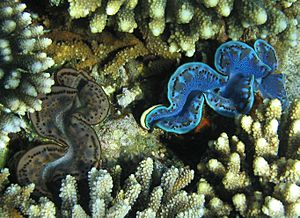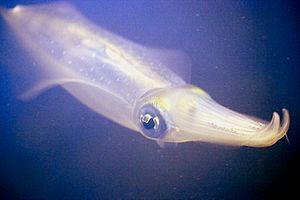List of molluscs of the Houtman Abrolhos facts for kids

The Houtman Abrolhos is a group of islands in the Indian Ocean, off the coast of Western Australia. It is a special place because it is home to many different kinds of marine animals, including a huge variety of molluscs. Molluscs are soft-bodied animals, many of which have shells. Think of snails, clams, octopuses, and squids – they are all molluscs!
Scientists have found 492 different types of marine molluscs living around the Houtman Abrolhos islands. This makes it a very important area for marine life.
Contents
What Kinds of Molluscs Live Here?
Most of the molluscs found here are:
- Gastropods (like snails and slugs): These make up about 70% of all the mollusc species.
- Bivalves (like clams, oysters, and mussels): These are about 25% of the species.
The rest are:
- Cephalopods (like octopuses and squids): About 14 species.
- Chitons (shellfish with eight plates): About 5 species.
- Scaphopods (tusk shells): About 4 species.
Many of these molluscs (about two-thirds) are typically found in warm, tropical waters. Around 20% prefer cooler, temperate waters. The remaining 11% are special because they are found only in Western Australia and nowhere else in the world!
Gastropods: The Snails and Slugs of the Sea
Gastropods are the largest group of molluscs. They usually have a single, spiral shell, but some, like sea slugs, have no shell at all. They move around on a muscular "foot."
Some interesting gastropods found at Houtman Abrolhos include:
- Cowries: These snails have beautiful, smooth, often colorful shells. Examples are Cypraea annulus and Cypraea tigris (Tiger cowry). The Cypraea moneta is also known as the Money cowry.
- Cones: These snails have cone-shaped shells and can be venomous. Conus anemone and Conus geographus are found here.
- Triton's Trumpet: The Charonia tritonis is a very large and impressive snail. Its shell is often used as a trumpet!
- Australian Pheasant Snail: Phasianella australis is known for its colorful shell.
- Sea Slugs (Nudibranchs): These are often brightly colored and have no shells. Examples include Hexabranchus sanguineus, also known as the Spanish dancer, which is a large, red sea slug.
Here are a few more examples of gastropods:
- Nerita albicilla
- Haliotis elegans
- Strombus mutabilis
- Bursa granularis
- Syrinx aruanus
- Melo miltonis (Southern bailer)
- Oliva australis
- Hydatina physis
- Bulla ampulla
- Aplysia dactylomela (Sea hare)
- Umbraculum sinicum
- Elysia australis
Bivalves: Clams, Oysters, and Mussels
Bivalves have two shells (valves) that are hinged together. They filter feed, meaning they take in water and filter out tiny food particles.
Some notable bivalves in the Houtman Abrolhos include:
- Giant Clams: The Tridacna maxima (Maxima clam) is a type of giant clam found here. These are some of the largest clams in the world.
- Pearl Oysters: Pinctada margaritifera is a species of pearl oyster, known for producing pearls.
- Scallops: Amusium balloti and Pecten fumatus are types of scallops.
- Oysters: Saccostrea cucullata is a common oyster species.
Other examples of bivalves:
- Pinna bicolor
- Malleus meridionalis
- Spondulus barbatus
- Hyotissa hyotis
- Neotrigonia bednalli
- Megacardita incrassata
- Acrosterigma alternatum
- Mactra incarnata
- Tellina perna
- Circe scripta
- Venus lamellaris
Cephalopods: The Smart Ones
Cephalopods are known for being very intelligent. This group includes octopuses, squids, and cuttlefish. They have arms or tentacles and can change color to hide or communicate.
Some cephalopods found here are:
- Ram's Horn Squid: Spirula spirula is a deep-sea squid with a unique internal shell shaped like a ram's horn.
- Cuttlefish: Sepia apama is the Australian giant cuttlefish, known for its amazing ability to change color and texture.
- Squids: Sepioteuthis lessoniana is a common squid species.
- Blue-ringed Octopuses: Hapalochlaena cf. maculosa (Southern blue-ringed octopus) and Hapalochlaena lunulata (Greater blue-ringed octopus) are found here. These small octopuses are famous for their bright blue rings that appear when they feel threatened.
Polyplacophora: The Chitons
Chitons are marine molluscs that have eight shell plates on their backs, which allows them to curl up for protection. They are often found clinging to rocks in shallow waters.
Examples found at Houtman Abrolhos include:
- Ischnochiton cariosus
- Cryptoplax striata
- Onithochiton quercina
Scaphopoda: The Tusk Shells
Scaphopods are also known as tusk shells because their shells are shaped like tiny elephant tusks. They live buried in sand or mud, with the narrow end of their shell sticking up into the water to breathe and feed.
Examples found here are:
- Dentalium elephantinum
- Dentalium formosum
- Solecurtus sulcatus
See also
 In Spanish: Anexo:Moluscos de Houtman Abrolhos para niños
In Spanish: Anexo:Moluscos de Houtman Abrolhos para niños
- List of marine molluscs of Australia


